
The city of Luxembourg is the capital of the namesake country, and with a population just above 100,000 it is the second smallest national capital of the European Union, after Malta's Valletta. Very different in character from the bustling metropoles of the continent, Luxembourg is defined by its mountainous location and spectacular elevations afforded by the deep and narrow valley of the rivers Alzette and Petrusse it was built upon. The city has historically been an inconquerable fortress, which led it to be nicknamed the "Gibraltar of the North".
Luxembourg may not feature on most tourists' bucket lists, but it sees a very generous share of incoming visitors every year for a city of that size. This is due to its importance in the European financial sector, with many banks and institutions having their headquarters or subsidiaries there. Moreover, as one of the founding members of the European Union, Luxembourg hosts a number of EU institutions. Finally, Luxembourg has favourable taxation regulations for international holding companies, so that many multinationals locate their European seats there. This all makes the small city have a very upscale and business feel, and the tourist industry there is geared towards the business traveller.
Luxembourg is officially divided into 24 districts. Some of those of interest to tourists:
- Ville Haute ("High City") - the medieval town core. Home to cafés, restaurants, and high street shops.
- Grund (Ville Basse) ("Low City") - situated in the gorge that cuts across the city and the most picturesque area.
- Gare ("Station") - the location of the train station, a 15-min walk south of Ville Haute and home to many restaurants and cafés.
- Kirchberg - a modern district across the Grand Duchess Charlotte Bridge in the north east of the City. The cityside eastern area of Kirchberg is home to many European Union institutions including the European Court of Justice, European Court of Auditors, parts of the European Commission, the Secretariat of the European Parliament and the European Investment Bank. The western end of the Kirchberg plateau is home to Luxembourg's thriving international financial services district. The Mudam modern art museum, the Philharmonie and the Dräi Eechelen fortress are near the Place de l'Europe beside the impressive EU institutions buildings.
- Hollerich - a formerly independent commune which was a prominent industrial site within Luxembourg. The remains of the industrial heritage are still to be seen around it.
Ville Haute ("High City") - the medieval town core. Home to cafés, restaurants, and high street shops.
Grund (Ville Basse) ("Low City") - situated in the gorge that cuts across the city and the most picturesque area.
Gare ("Station") - the location of the train station, a 15-min walk south of Ville Haute and home to many restaurants and cafés.
Kirchberg - a modern district across the Grand Duchess Charlotte Bridge in the north east of the City. The cityside eastern area of Kirchberg is home to many European Union institutions including the European Court of Justice, European Court of Auditors, parts of the European Commission, the Secretariat of the European Parliament and the European Investment Bank. The western end of the Kirchberg plateau is home to Luxembourg's thriving international financial services district. The Mudam modern art museum, the Philharmonie and the Dräi Eechelen fortress are near the Place de l'Europe beside the impressive EU institutions buildings.
Hollerich - a formerly independent commune which was a prominent industrial site within Luxembourg. The remains of the industrial heritage are still to be seen around it.
The pedestrianized old town. This is where the greatest concentration of (rather expensive) shops as well as bars and restaurants are to be found. Specific sights are few but all around town you can spot details that remind you of Luxembourg's historical value.
- The Bock. The rock on which the first castle stood, founded in 963 by Sigefroy (Sigfried). It is tied to a number of other remains of the old fortifications. Among others, the famous fortress builder Vauban built much in the city.
- Bock Casemates, +352 222809. A network of underground fortifications, built in the 18th century. The fortifications and environs are recognized as a UNESCO World Heritage Site.
- Eglise St. Michel. This church took on its present form in 1688, but was probably built in the early 14th century. It was restored during 2003 and 2004.
- National Museum of History and Art. A very diverse museum, organized around the four departments of archaeology, coins and medals, decorative art, and fine art. Free for permanent collections, but temporary exhibitions may have a cost.

- Grand Ducal Palace. Fully restored during the 1990s. It also houses the Luxembourgish Parliament the Chamber of Deputies. The palace is open for a period of 6 weeks over July and August whilst the Grand Duke and his family are away on their holidays. Guided tours last for about 1 hr, are inexpensive, and are available in various languages, including English. Tickets are available from the tourist office in Place de Guillaume II.
- Le Chemin de la Corniche. Pedestrian promenade along the rim of the Alzette gorge, described as Europe's most beautiful balcony.
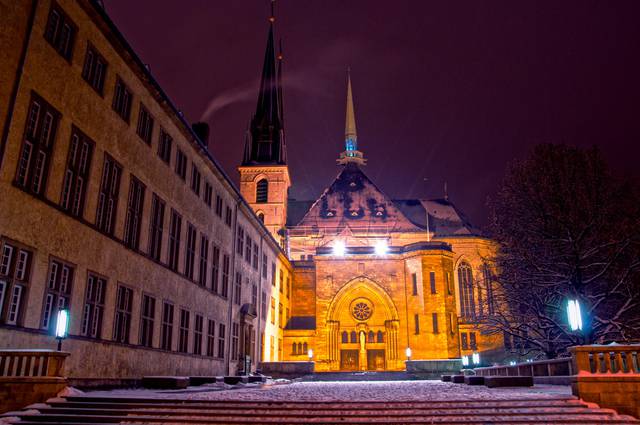
- Luxembourg City Museum. Museum about the history of the City of Luxembourg. The entire 1,000-year history is covered, though there is more emphasis on the social and economic history of the period after Luxembourg emerged as a fully independent state in the 19th and 20th centuries. Text displays are all in English, in addition to French and German.
- Cathedrale de Notre Dame. Built between 1613 and 1618 by Jesuits and was elevated to the status of cathedral in 1870. Nearby is the Gëlle Fra: literally 'Golden Lady'. This is a golden figure of a woman holding a wreath, a symbol of victory. It was taken down by the Nazis during occupation but stands today as a memorial to those who gave their lives in World War II.
- Pétrusse Casemates. Constructed by the Spanish in 17th century. They are not as large as the Bock Casements.
- Hotel de Ville.
- Place Guillaume. Place Guillaume (also known in Luxembourgish as the "Knuedler") is the venue for a market every Wednesday and Saturday. It is also the site of an equestrian statue of William II of the Netherlands and Luxembourg and the neo-classical Town Hall which is fronted by two bronze lions.
- Place d'Armes. In summer months the Place d'Armes is filled with tables and chairs from the surrounding cafes and at the centre of the square is the bandstand around which various concert seasons are based.
- Casino Luxemburg. Contemporary art forum with changing exhibitions.
- Pfaffenthal Lift.
The Bock. The rock on which the first castle stood, founded in 963 by Sigefroy (Sigfried). It is tied to a number of other remains of the old fortifications. Among others, the famous fortress builder Vauban built much in the city.
Bock Casemates, +352 222809. A network of underground fortifications, built in the 18th century. The fortifications and environs are recognized as a [[UNESCO World Heritage Site]].
Eglise St. Michel. This church took on its present form in 1688, but was probably built in the early 14th century. It was restored during 2003 and 2004.
National Museum of History and Art. A very diverse museum, organized around the four departments of archaeology, coins and medals, decorative art, and fine art. Free for permanent collections, but temporary exhibitions may have a cost.
Grand Ducal Palace. Fully restored during the 1990s. It also houses the Luxembourgish Parliament the Chamber of Deputies. The palace is open for a period of 6 weeks over July and August whilst the Grand Duke and his family are away on their holidays. Guided tours last for about 1 hr, are inexpensive, and are available in various languages, including English. Tickets are available from the tourist office in Place de Guillaume II.
Le Chemin de la Corniche. Pedestrian promenade along the rim of the Alzette gorge, described as Europe's most beautiful balcony.
Luxembourg City Museum. Museum about the history of the City of Luxembourg. The entire 1,000-year history is covered, though there is more emphasis on the social and economic history of the period after Luxembourg emerged as a fully independent state in the 19th and 20th centuries. Text displays are all in English, in addition to French and German.
Cathedrale de Notre Dame. Built between 1613 and 1618 by Jesuits and was elevated to the status of cathedral in 1870. Nearby is the Gëlle Fra: literally 'Golden Lady'. This is a golden figure of a woman holding a wreath, a symbol of victory. It was taken down by the Nazis during occupation but stands today as a memorial to those who gave their lives in World War II.
Pétrusse Casemates. Constructed by the Spanish in 17th century. They are not as large as the Bock Casements.
Hotel de Ville.
Place Guillaume. Place Guillaume (also known in Luxembourgish as the "Knuedler") is the venue for a market every Wednesday and Saturday. It is also the site of an equestrian statue of William II of the Netherlands and Luxembourg and the neo-classical Town Hall which is fronted by two bronze lions.
Place d'Armes. In summer months the Place d'Armes is filled with tables and chairs from the surrounding cafes and at the centre of the square is the bandstand around which various concert seasons are based.
Casino Luxemburg. Contemporary art forum with changing exhibitions.
Pfaffenthal Lift.
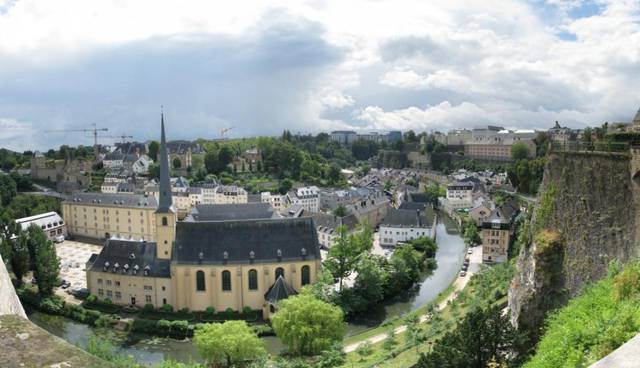
- Grund. The Alzette, thought it is very small now, because the sandstone of the area is very soft, it dug out a huge valley. This is called the Ville Basse and is a spectacular area particularly the Grund (Statgrond) which is well worth the time to take a stroll around. The old fortress surrounded this valley. The Venceslas walk (named after Venceslas, Czech king and count of Luxembourg who built much of the fortresses around) leads along the fortresses, protecting the city on one side (and now forming one of the most spectacular "balconies", the Corniche) and the fortress of the Raam plateau on the other.
- Neumünster Abbey. Now a cultural and encounter center with a nice church and the old St. John's hospital.
- National Museum of Natural History. Splendid expositions on minerals, animals, evolution, etc. There is a temporary exposition on animals by night (until August 4, 2019) Adults €5.
Grund. The Alzette, thought it is very small now, because the sandstone of the area is very soft, it dug out a huge valley. This is called the Ville Basse and is a spectacular area particularly the Grund (Statgrond) which is well worth the time to take a stroll around. The old fortress surrounded this valley. The Venceslas walk (named after Venceslas, Czech king and count of Luxembourg who built much of the fortresses around) leads along the fortresses, protecting the city on one side (and now forming one of the most spectacular "balconies", the Corniche) and the fortress of the Raam plateau on the other.
Neumünster Abbey. Now a cultural and encounter center with a nice church and the old St. John's hospital.
National Museum of Natural History. Splendid expositions on minerals, animals, evolution, etc. There is a temporary exposition on animals by night (until August 4, 2019) Adults €5.

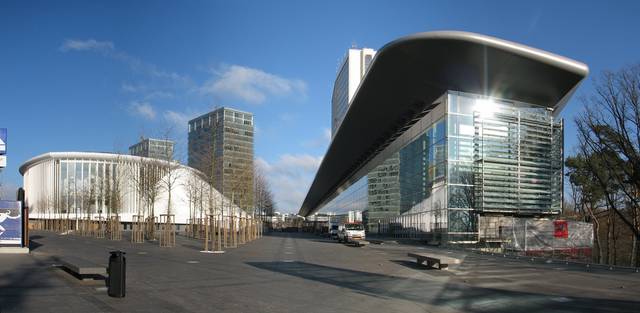
- The Kirchberg area. This area houses a number of banks and most of the European institutions in Luxembourg (Parliament, Court of Justice, Court of Auditors, European Investment Bank and some of the Commission's Directorate Generals). A number of buildings were built by celebrated architects like Richard Meyer, Dominique Perrault and Gottfried Benn. Some modern sculptures also appear between the buildings. Most of the European Institutions hold annual open days. Many of the banks, EU institutions and other offices open their doors to the public once a year to allow access to their extensive art collections. MUDAM
- MUDAM, 3, Park Dräi Eechelen (Kirchberg, buses 1, 3, 6, Eurobus. Designed by I.M. Pei of "Louvre Pyramid" fame, this museum showcases Luxembourgish artists and changing international exhibitions. The nonlinear (and rather confusing) building is half the fun, and on a quiet weekday afternoon in the off season you'll pretty much have the place to yourself. €5.
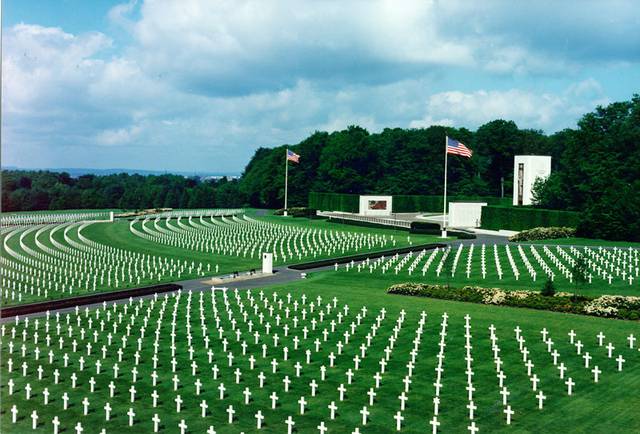
- Musée Dräi Eechelen. Museum about the history of the Luxembourg Fortress inside an 18th century fort.
- Pfaffenthal–Kirchberg funicular.
The Kirchberg area. This area houses a number of banks and most of the European institutions in Luxembourg (Parliament, Court of Justice, Court of Auditors, European Investment Bank and some of the Commission's Directorate Generals). A number of buildings were built by celebrated architects like Richard Meyer, Dominique Perrault and Gottfried Benn. Some modern sculptures also appear between the buildings. Most of the European Institutions hold annual open days. Many of the banks, EU institutions and other offices open their doors to the public once a year to allow access to their extensive art collections.
MUDAM, 3, Park Dräi Eechelen (Kirchberg, buses 1, 3, 6, Eurobus. Designed by I.M. Pei of "Louvre Pyramid" fame, this museum showcases Luxembourgish artists and changing international exhibitions. The nonlinear (and rather confusing) building is half the fun, and on a quiet weekday afternoon in the off season you'll pretty much have the place to yourself. €5.
Musée Dräi Eechelen. Museum about the history of the Luxembourg Fortress inside an 18th century fort.
Pfaffenthal–Kirchberg funicular.
- Bank Museum, 1, Place de Metz. M-F 09:00-17:30. Free.
- Am Tunnel, 16, rue Ste Zithe. M-F 09:00-17:30, Su 14:00-18:00. Art exhibitions inside by Luxembourg's savings bank. Free.
Bank Museum, 1, Place de Metz. M-F 09:00-17:30. Free.
Am Tunnel, 16, rue Ste Zithe. M-F 09:00-17:30, Su 14:00-18:00. Art exhibitions inside by Luxembourg's savings bank. Free.
- World War II Luxembourg American Cemetery and Memorial. In the eastern section of Luxembourg City, just south of the airport. Open daily except for December 25 and January 1; 09:00-17:00. The cemetery is the final resting place for 5,076 American military dead, most lost during the Battle of the Bulge. It is also the final resting place for General George Patton. A monument is inscribed with the names of 371 Americans whose remains were never found or identified. Two large stone pylons with operations maps made of inlaid granite describe the achievements of American armed forces in the region during World War II. Free.
- Cemetery for German soldiers at Sandweiler, L-5280 Sandweiler, +352 35 50 07. A World War II cemetery in Sandweiler, in southern Luxembourg. It contains the graves of 10,913 German servicemen from the Battle of the Bulge in winter 1944 and spring 1945. It is 1.5 km from the Luxembourg American Cemetery and Memorial. Devoted to the fallen German soldiers from one of the bloodiest battles of World War II. A touching memorial.
- Tramways and Bus Museum. The Museum is next door to the AVL bus depot in Hollerich Free.
World War II Luxembourg American Cemetery and Memorial. In the eastern section of Luxembourg City, just south of the airport. Open daily except for December 25 and January 1; 09:00-17:00. The cemetery is the final resting place for 5,076 American military dead, most lost during the Battle of the Bulge. It is also the final resting place for General George Patton. A monument is inscribed with the names of 371 Americans whose remains were never found or identified. Two large stone pylons with operations maps made of inlaid granite describe the achievements of American armed forces in the region during World War II. Free.
Cemetery for German soldiers at Sandweiler, L-5280 Sandweiler, +352 35 50 07. A World War II cemetery in Sandweiler, in southern Luxembourg. It contains the graves of 10,913 German servicemen from the Battle of the Bulge in winter 1944 and spring 1945. It is 1.5 km from the Luxembourg American Cemetery and Memorial. Devoted to the fallen German soldiers from one of the bloodiest battles of World War II. A touching memorial.
Tramways and Bus Museum. The Museum is next door to the AVL bus depot in Hollerich Free.
- Schueberfouer, Glacis. Held every year in 2 weeks during end of August and early September, this huge and historic funfair attracts enormous crowds. As well as the many stomach churning rides there are numerous places to eat and drink to your heart's content. An important date in the social calendar of young Luxembourgers.
- National Holiday. While not the birthday of the current Grand Duke (or any preceding for that matter), June 23 is the country's national day. All-night street parties, fireworks and parades are enjoyed by seemingly the entire population of the country on the evening preceding the holiday.
- Utopolis Kirchberg. Cinema.
- Philharmonie Luxembourg. Classical concerts.
- LUXEXPO. Exhibition centre.
- Grand Théâtre de Luxembourg. Major venue for drama, opera and ballet.
- Swing Dance Luxembourg. Social dance on Mondays. During the summer it is outdoors in various locations; at other times it is at Scott’s Pub in Grund.
Schueberfouer, Glacis. Held every year in 2 weeks during end of August and early September, this huge and historic funfair attracts enormous crowds. As well as the many stomach churning rides there are numerous places to eat and drink to your heart's content. An important date in the social calendar of young Luxembourgers.
National Holiday. While not the birthday of the current Grand Duke (or any preceding for that matter), June 23 is the country's national day. All-night street parties, fireworks and parades are enjoyed by seemingly the entire population of the country on the evening preceding the holiday.
Utopolis Kirchberg. Cinema.
Philharmonie Luxembourg. Classical concerts.
LUXEXPO. Exhibition centre.
Grand Théâtre de Luxembourg. Major venue for drama, opera and ballet.
Swing Dance Luxembourg. Social dance on Mondays. During the summer it is outdoors in various locations; at other times it is at Scott’s Pub in Grund.
For information, guidance and ideas, head over to the websites of the UCVL (Luxembourg City Trade Association) and Goodidea.lu.
- Cityshopping Info Point, Place D'Armes. Luxembourg takes promoting shopping in the city very seriously to the point that the Luxembourg City Trade Association and the authorities opened an information point in the very centre to provide guidance and suggestions regarding all your possible shopping needs and interests.
- Smets Luxury Outlet, Rue Beaumont 20. M 11:00-18:30, Tu-Sa 10:00-18:30. Pascaline Smets operates the family-owned business of multiple high-end boutiques throughout Luxembourg, offering the best fashion brands. Whatever doesn't sell by the end of the season, however, ends up at her luxury outlet in rue Beaumont, where you can fetch a bargain with your favourite label.
- Ernster, rue du Fossé 27. M-Sa 09:00-18:30. A family business operating for over a century, the Ernster bookstore grew to be a five-storey paradise for bookworms with a wide selection of books in many languages, as well as a special section for children. Apart from the main store, you can find Ernster in the Belle Etoile shopping centre and in several other locations throughout the Grand Duchy of Luxembourg.
Cityshopping Info Point, Place D'Armes. Luxembourg takes promoting shopping in the city very seriously to the point that the Luxembourg City Trade Association and the authorities opened an information point in the very centre to provide guidance and suggestions regarding all your possible shopping needs and interests.
Smets Luxury Outlet, Rue Beaumont 20. M 11:00-18:30, Tu-Sa 10:00-18:30. Pascaline Smets operates the family-owned business of multiple high-end boutiques throughout Luxembourg, offering the best fashion brands. Whatever doesn't sell by the end of the season, however, ends up at her luxury outlet in rue Beaumont, where you can fetch a bargain with your favourite label.
Ernster, rue du Fossé 27. M-Sa 09:00-18:30. A family business operating for over a century, the Ernster bookstore grew to be a five-storey paradise for bookworms with a wide selection of books in many languages, as well as a special section for children. Apart from the main store, you can find Ernster in the Belle Etoile shopping centre and in several other locations throughout the Grand Duchy of Luxembourg.
- Monthly Market in Glacis. Every 3rd Sunday of the month. Every month in the expansive Glacis square in Limpertsberg a market takes place, which is a mixture of a flea market, a farmer's market and some local arts & crafts. Browse and enjoy the best Luxembourg has to offer if you are in the city for the date.
- Weekly Market in Bonnevoie. Every Wednesday, 07:00-13:30. Bonnevoie hosts a weekly market every Wednesday in front of the parish church
- Market in Place de Paris, Place de Paris. W and Sa 07:00-13:30. The district of Gare holds markets in Place de Paris twice a week.
- Market in Place Guillaume II. W and Sa 07:00-13:30. Place Guillaume II plays host to a market twice a week.
- lët’z go local. The organisation with the jocular name seeks to promote local Luxembourgish produce of all kinds, be it food, drinks, fashion, design or even leisure services. They organize markets multiple times every year in varying locations in Luxembourg to showcase the offer of their members.
Monthly Market in Glacis. Every 3rd Sunday of the month. Every month in the expansive Glacis square in Limpertsberg a market takes place, which is a mixture of a flea market, a farmer's market and some local arts & crafts. Browse and enjoy the best Luxembourg has to offer if you are in the city for the date.
Weekly Market in Bonnevoie. Every Wednesday, 07:00-13:30. Bonnevoie hosts a weekly market every Wednesday in front of the parish church
Market in Place de Paris, Place de Paris. W and Sa 07:00-13:30. The district of Gare holds markets in Place de Paris twice a week.
Market in Place Guillaume II. W and Sa 07:00-13:30. Place Guillaume II plays host to a market twice a week.
lët’z go local. The organisation with the jocular name seeks to promote local Luxembourgish produce of all kinds, be it food, drinks, fashion, design or even leisure services. They organize markets multiple times every year in varying locations in Luxembourg to showcase the offer of their members.
- Auchan Luxembourg, Rue Alphonse Weicker 5. A fairly unremarkable yet large shopping gallery, anchored by a bi-level Auchan hypermarket, the only store of the French chain in the country.
Auchan Luxembourg, Rue Alphonse Weicker 5. A fairly unremarkable yet large shopping gallery, anchored by a bi-level Auchan hypermarket, the only store of the French chain in the country.
Home to a surprisingly high number of Michelin star establishments, the city houses many fine eateries. Luxembourg also has a very large population of Italians who came to the country in the late 19th century so pizzerias in Luxembourg are always very reliable and frequent. For something cheap and quick the Place d'Armes is the best bet.
- La Fontaine, 25, place de Paris, +352 494076. One of a number of affordable bistros clustered around place de Paris, conveniently located halfway between the station and the old city. The quadrilingual menus run the gamut from pizza and mussels to Luxembourgish classics like judd mat gaardebounen (smoked pork neck with broad beans), and there are daily specials for around €8. €20.
- Taj Mahal, 2, rue de Strasbourg, +352 40 59 41. By anyone's standards, a fantastic curry house serving rich and delicious Indian food. Very friendly staff too. Well worth making the short trip from the centre to this restaurant located near the station.
- Mousel Cantine, 46, Montée de Clausen, +352 470198. Great local plates on the site of the former Mousel brewery. Wash down huge portions of pork knee and broad beans with tankards of Mousel lager. €25.
- Le Palais D'Asie, 47, avenue de la Liberté. Don kimonos and marvel at the skill of the chefs as they prepare Japanese and Chinese style cuisine before your very eyes including ceiling-high flames and an "egg show". As entertaining as it is tasty. Arrive hungry as the portions are generous.
- Chez Julie, 17 Rue de Bonnevoie (at gare, +352 26 29 69 70. M-F 07:15-17:00. Vegetarian and organic food in small lunch restaurant. Excellent pies, soups, salads and cakes. The tables are small with little space between them, so you get a chance to say hello to your neighbors. No alcohol served, Free WiFi. €15.
- Aime La Fourchette, Avenue Monterey 5 (close to Place d'Armes. Solid and good bistro food.
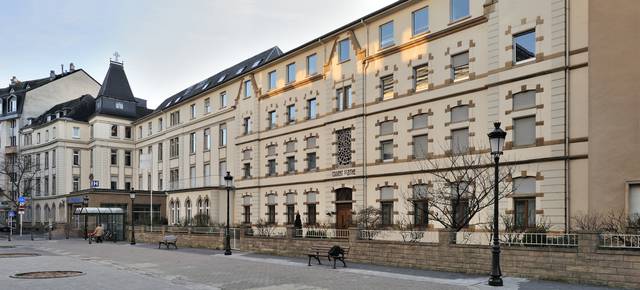
- L'Etoile du Top Floor, Boulevard d Avranches 40. Daily 12:00-14:30 & 19:00-23:30. The restaurant atop the Sofitel Grand Ducal in Bonnevoie, led by chef Sebastien Perrot, affords one of the best views over Luxembourg along with the finest cuisine.
La Fontaine, 25, place de Paris, +352 494076. One of a number of affordable bistros clustered around place de Paris, conveniently located halfway between the station and the old city. The quadrilingual menus run the gamut from pizza and mussels to Luxembourgish classics like judd mat gaardebounen (smoked pork neck with broad beans), and there are daily specials for around €8. €20.
Taj Mahal, 2, rue de Strasbourg, +352 40 59 41. By anyone's standards, a fantastic curry house serving rich and delicious Indian food. Very friendly staff too. Well worth making the short trip from the centre to this restaurant located near the station.
Mousel Cantine, 46, Montée de Clausen, +352 470198. Great local plates on the site of the former Mousel brewery. Wash down huge portions of pork knee and broad beans with tankards of Mousel lager. €25.
Le Palais D'Asie, 47, avenue de la Liberté. Don kimonos and marvel at the skill of the chefs as they prepare Japanese and Chinese style cuisine before your very eyes including ceiling-high flames and an "egg show". As entertaining as it is tasty. Arrive hungry as the portions are generous.
Chez Julie, 17 Rue de Bonnevoie (at gare, +352 26 29 69 70. M-F 07:15-17:00. Vegetarian and organic food in small lunch restaurant. Excellent pies, soups, salads and cakes. The tables are small with little space between them, so you get a chance to say hello to your neighbors. No alcohol served, Free WiFi. €15.
Aime La Fourchette, Avenue Monterey 5 (close to Place d'Armes. Solid and good bistro food.
L'Etoile du Top Floor, Boulevard d Avranches 40. Daily 12:00-14:30 & 19:00-23:30. The restaurant atop the Sofitel Grand Ducal in Bonnevoie, led by chef Sebastien Perrot, affords one of the best views over Luxembourg along with the finest cuisine.
Luxembourg is a decent place to have a drink. Owing to the number of ex-pats who live in Luxembourg there are a wide variety of establishments in addition to the Luxembourgish bars. Pubs in Luxembourg tend to be a traditional affair, although more modern bars, and English or Irish themed pubs have also become the norm. Luxembourg is a low-key capital city and is generally not the best place for big nights out, although during the months of warmer weather it can have its moments. English themed pubs
- Britannia Pub, Rue de Clausen 1342. A favourite watering hole of local English ex-pats. Good place for watching football and rugby.
- Decibel, 42-44 Rue de Hollerich, +352 27 36 53 35. A music bar in a courtyard alongside other bars and restaurants off the lively rue de Hollerich, an eclectic range of music can be heard here and Decibel has one of the widest range of Belgian beers in the city on tap and in bottles. It is run by Irish people so the Guinness is decent as well.
- The Black Stuff, 15 Val de Hamm, +352 42 54 96. The Black Stuff is an Irish pub on the outskirts of the city that is popular with ex-pats and locals alike. In the winter the log fire makes the cosy back room a good option to enjoy a Guinness or a hot port, the terrace is popular in the summer. It is a popular place to watch Football and rugby and the best place in Luxembourg to watch televised Gaelic Football and Hurling.
- Pygmalion, Rue de la Tour Jacob 19. Or the Pyg, an Irish pub and the best of the English, Scottish, Irish triumvirate in Clausen. Pub quizzes every other Monday.
- Crossfire. A Scandinavian pub off Ave. de la Liberté, small and friendly.
- Scott's. No. 4, Bisserwee (down in the Grund). A common place for a drink (or two).
- Urban, Rue de la Boucherie 2. A refreshingly modern bar that has a wide mix of clientèle. Although often overcrowded it is a great place to start a night out. Urban also has live music every Sunday evening and has sporting events shown on two massive plasma screens.
- The Tube. Subterranean, London Underground-themed bar. International young crowd and great tunes for various tastes. Gets extremely packed late on Fridays and Saturdays and overspills into the street during warmer months.
- Vis-a-vis, Rue Beaumont 2 (Near Place d'Armes, +352 46 03 26. Hang out with the locals in this charming little Luxembourgish bar. Cheaper than a lot of other watering holes found in the city.
- Café des Artistes. Smokey little Luxembourg piano bar illuminated by candlelight.
- Melusina, Rue de la Tour Jacob 145. Has a large main room with a balcony. It also has another couple of rooms at the back of the club which are worth a look.
- Magnum. It's near the big parking lot (Glacis) just outside of the centre, but worth the walk there. No heels are too high and no skirts/shorts are too short here.
- Coco Mango, Boulevard d'Avranches 40 (at the Sofitel Grand Ducal. The bar of hotel Sofitel Grand Ducal enjoys some of the best views over the city. Pop in for a drink and enjoy!
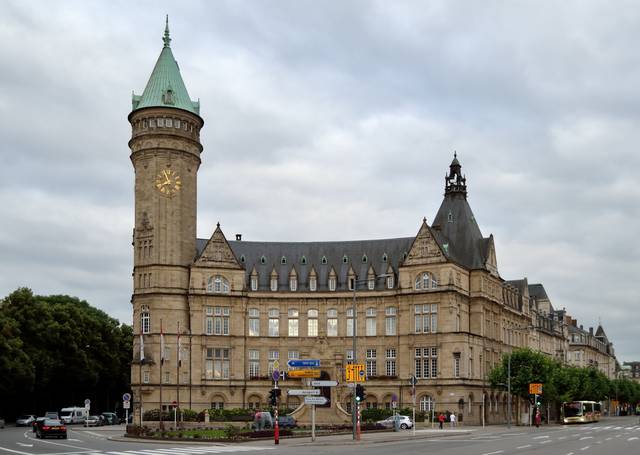
Britannia Pub, Rue de Clausen 1342. A favourite watering hole of local English ex-pats. Good place for watching football and rugby.
Decibel, 42-44 Rue de Hollerich, +352 27 36 53 35. A music bar in a courtyard alongside other bars and restaurants off the lively rue de Hollerich, an eclectic range of music can be heard here and Decibel has one of the widest range of Belgian beers in the city on tap and in bottles. It is run by Irish people so the Guinness is decent as well.
The Black Stuff, 15 Val de Hamm, +352 42 54 96. The Black Stuff is an Irish pub on the outskirts of the city that is popular with ex-pats and locals alike. In the winter the log fire makes the cosy back room a good option to enjoy a Guinness or a hot port, the terrace is popular in the summer. It is a popular place to watch Football and rugby and the best place in Luxembourg to watch televised Gaelic Football and Hurling.
Pygmalion, Rue de la Tour Jacob 19. Or the Pyg, an Irish pub and the best of the English, Scottish, Irish triumvirate in Clausen. Pub quizzes every other Monday.
Crossfire. A Scandinavian pub off Ave. de la Liberté, small and friendly.
Scott's. No. 4, Bisserwee (down in the Grund). A common place for a drink (or two).
Urban, Rue de la Boucherie 2. A refreshingly modern bar that has a wide mix of clientèle. Although often overcrowded it is a great place to start a night out. Urban also has live music every Sunday evening and has sporting events shown on two massive plasma screens.
The Tube. Subterranean, London Underground-themed bar. International young crowd and great tunes for various tastes. Gets extremely packed late on Fridays and Saturdays and overspills into the street during warmer months.
Vis-a-vis, Rue Beaumont 2 (Near Place d'Armes, +352 46 03 26. Hang out with the locals in this charming little Luxembourgish bar. Cheaper than a lot of other watering holes found in the city.
Café des Artistes. Smokey little Luxembourg piano bar illuminated by candlelight.
Melusina, Rue de la Tour Jacob 145. Has a large main room with a balcony. It also has another couple of rooms at the back of the club which are worth a look.
Magnum. It's near the big parking lot (Glacis) just outside of the centre, but worth the walk there. No heels are too high and no skirts/shorts are too short here.
Coco Mango, Boulevard d'Avranches 40 (at the Sofitel Grand Ducal. The bar of hotel Sofitel Grand Ducal enjoys some of the best views over the city. Pop in for a drink and enjoy!
Try to show respect for the local language and make some effort to say a word or two of it even if it's just the standard greeting "Moien". In restaurants and high-end service establishments the personnel are generally expected to serve you in French, so if you speak French, do use it.
Luxembourg is a safer environment than most other European capital cities, and it would be rare to encounter any physical threat. Nevertheless, care is required in the area around the train station (especially late at night), which contains a handful of seedy clubs and prostitutes, mainly on the rue de Strasbourg and the surrounding streets.
- NetherlandsThe Netherlands, 6, rue Sainte Zithe, +35 222 75 70. Mo-Fr 9AM-12.30AM.
- United Kingdom United Kingdom, 5, Boulevard Joseph II, +352 22 98 64. Consular services are only provided by appointment, which can be booked online via their website.
- United States United States, 22 Boulevard Emmanuel Servais, +352 46 01 23. M-F 08:30-17:30.
NetherlandsThe Netherlands, 6, rue Sainte Zithe, +35 222 75 70. Mo-Fr 9AM-12.30AM.
United Kingdom United Kingdom, 5, Boulevard Joseph II, +352 22 98 64. Consular services are only provided by appointment, which can be booked online via their website.
United States United States, 22 Boulevard Emmanuel Servais, +352 46 01 23. M-F 08:30-17:30.
- Vianden
- Echternach
- Mullerthal
- Trier (Germany)
- Metz (France) - By train is €16.50.
- Arlon (Belgium)
